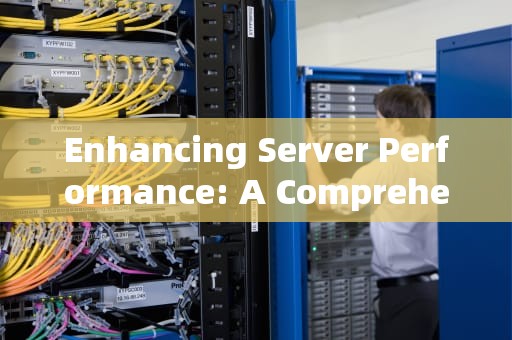In the digital age, where data is the lifeblood of modern enterprises and online services form the backbone of our daily interactions, server performance has become a critical factor in ensuring seamless operations and user satisfaction. From hosting websites to running complex applications, servers play a pivotal role, and their efficiency directly impacts the overall user experience. This article delves into the key aspects of server performance, exploring strategies to enhance it, understanding the metrics that matter, and addressing common challenges faced by administrators.

Understanding Server Performance
Server performance refers to the ability of a server to process requests, execute tasks, and deliver data efficiently and quickly. It encompasses various factors such as response time, throughput, resource utilization, and scalability. A high-performing server ensures minimal latency, fast load times, and reliable handling of concurrent users, which are crucial for maintaining a competitive edge in today's fast-paced digital landscape.
Key Metrics for Measuring Server Performance
1、Response Time: This measures the time taken by the server to respond to a client's request. Lower response times indicate better performance and user experience.
2、Throughput: The number of requests or transactions a server can handle per unit time. High throughput is essential for handling peak loads without compromising performance.
3、CPU Utilization: Indicates how effectively the server's CPU is being used. Ideally, it should be optimized to avoid overutilization or underutilization.
4、Memory Usage: Reflects the amount of RAM consumed by running processes. Efficient memory management prevents slowdowns due to excessive swapping.
5、Disk I/O: Measures the speed at which data is read from and written to the disk. Faster disk I/O enhances overall system responsiveness.
6、Network Latency: The delay experienced in data transmission across networks. Lower latency improves real-time communication and data transfer rates.
Strategies to Enhance Server Performance
Investing in powerful hardware components like multi-core processors, solid-state drives (SSDs), and ample RAM can significantly boost server performance. Upgrading to the latest generation of CPUs and using NVMe SSDs instead of traditional hard drives can drastically reduce processing times and increase data access speeds.
2. Optimizing Software Configurations
Proper configuration of server software, including operating systems, databases, and web servers, is vital. This involves tuning parameters based on workload patterns, enabling caching mechanisms, and applying performance patches and updates regularly.
Implementing load balancers distributes incoming traffic across multiple servers, preventing any single server from becoming overwhelmed. This not only enhances performance but also ensures high availability and fault tolerance.
4. Content Delivery Networks (CDNs)
Utilizing CDNs caches static content closer to end-users geographically, reducing the distance data must travel and thus decreasing latency. CDNs are particularly effective for globally distributed audiences.
5. Database Optimization
Optimizing database queries, indexing frequently accessed data, and partitioning large tables can greatly improve database performance. Additionally, employing database replication and clustering techniques enhances data redundancy and access speed.
6. Compression and Minification
Compressing files (like images, CSS, and JavaScript) and minifying code reduces their size, leading to faster download times and reduced bandwidth consumption.
7. Regular Monitoring and Maintenance
Continuous monitoring using tools like Nagios, Zabbix, or New Relic helps identify performance bottlenecks and potential issues before they escalate. Scheduled maintenance tasks, such as cleaning up logs and defragmenting disks, also contribute to optimal performance.
Addressing Common Server Performance Challenges
As businesses grow, so does the demand on servers. Planning for scalability involves adopting cloud solutions that allow for easy resource scaling, implementing auto-scaling groups, and designing applications with horizontal scalability in mind.
Ensuring server security while maintaining performance can be challenging. Implementing robust firewall rules, regular security audits, and using encryption protocols without sacrificing too much processing power are crucial steps.
Balancing performance needs with cost efficiency often requires careful planning. Opting for virtualized environments, leveraging cloud bursting strategies, and negotiating with vendors for better pricing models can help manage costs effectively.
Compatibility and Integration
When upgrading or integrating new systems, compatibility issues may arise. Thorough testing in staging environments and adhering to industry standards ensure smooth transitions without disrupting existing workflows.
Emerging Technologies Shaping Server Performance
Artificial Intelligence (AI) and Machine Learning (ML)
AI and ML algorithms are increasingly being used to predict server load, automate optimizations, and detect anomalies in real-time. These technologies enable proactive performance management, enhancing overall efficiency.
By processing data closer to the source (at the 'edge' of the network), edge computing reduces latency and bandwidth usage, especially beneficial for IoT devices and real-time applications.
Containerization and Orchestration
Containers package applications with their dependencies, allowing for consistent deployment across environments. Orchestration tools like Kubernetes automate container management, improving resource allocation and scalability.
Conclusion
Server performance is a multifaceted aspect that requires continuous attention and optimization. By understanding the key metrics, implementing effective strategies, addressing common challenges head-on, and embracing emerging technologies, organizations can ensure their servers operate at peak efficiency, delivering exceptional experiences to users worldwide. As technology continues to evolve, staying ahead in the realm of server performance will remain a dynamic journey, demanding adaptability, innovation, and a commitment to excellence.
随着互联网的普及和信息技术的飞速发展台湾vps云服务器邮件,电子邮件已经成为企业和个人日常沟通的重要工具。然而,传统的邮件服务在安全性、稳定性和可扩展性方面存在一定的局限性。为台湾vps云服务器邮件了满足用户对高效、安全、稳定的邮件服务的需求,台湾VPS云服务器邮件服务应运而生。本文将对台湾VPS云服务器邮件服务进行详细介绍,分析其优势和应用案例,并为用户提供如何选择合适的台湾VPS云服务器邮件服务的参考建议。

工作时间:8:00-18:00
电子邮件
1968656499@qq.com
扫码二维码
获取最新动态
